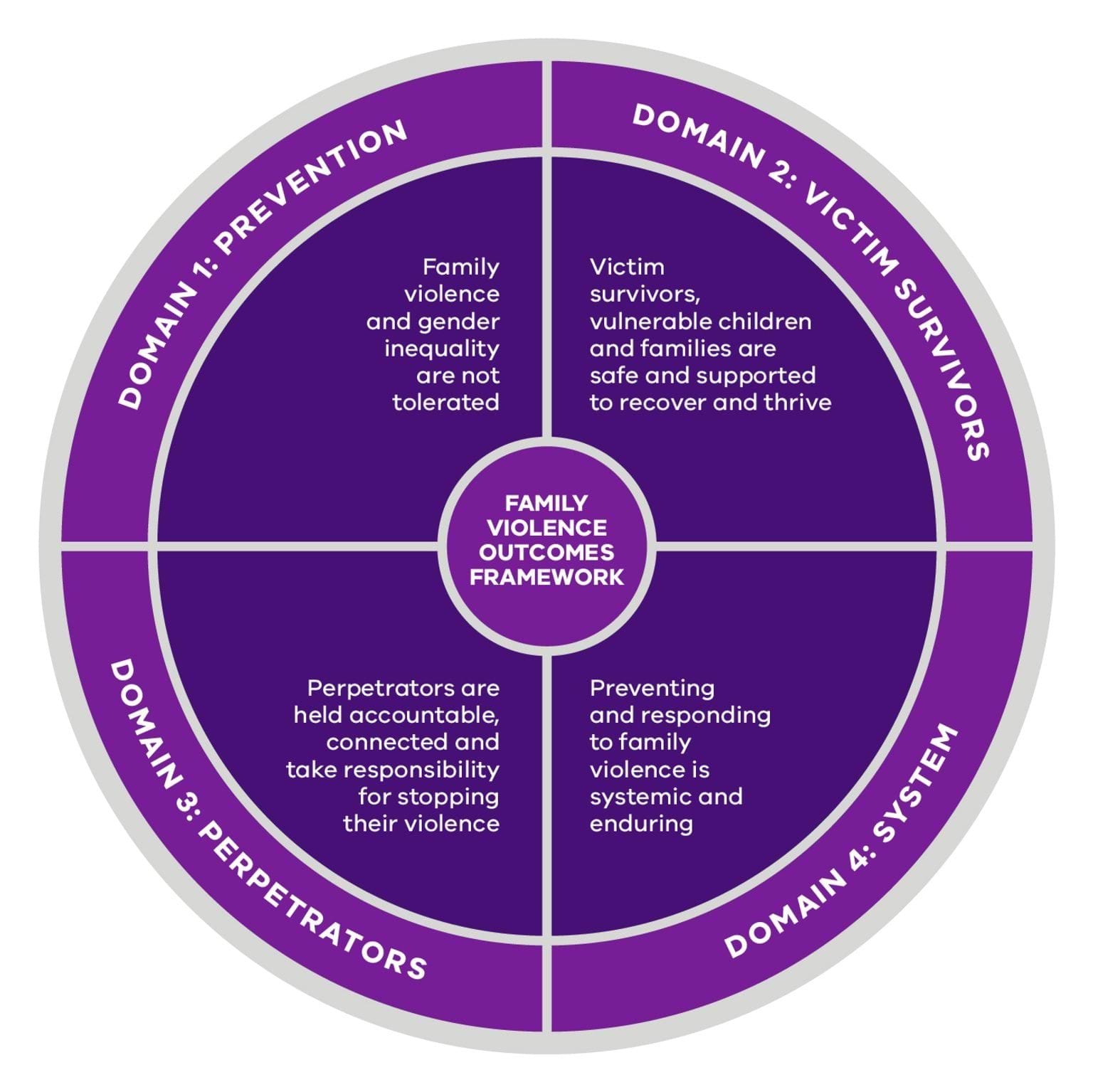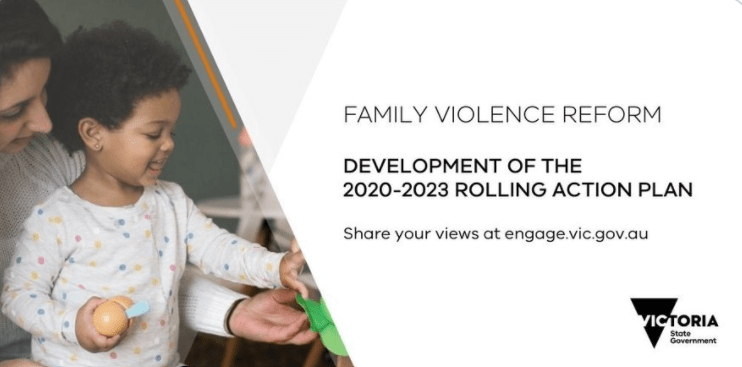Overview
Over the next phase of the reform we will continue to monitor progress against 'Ending Family Violence: Victoria's Plan for Change' (the 10-year plan) by linking governance and oversight of the reform agenda even more closely to the outcomes we want to see and the actions we are taking.
Over the last four years we have established effective reform oversight, and governance has evolved to respond to the maturity and progress of the reform. This is consistent with findings by the Family Violence Reform Implementation Monitor that governance should adapt over the life of the reform.
We know that reform needs to be underpinned by strong governance arrangements and transparent reporting.
Reform governance
Our governance and reporting structures will continue to adapt to reflect the current stage of reform implementation and provide insight into the impact of the reform.
The Victorian Secretaries Board and the Family Violence Reform Interdepartmental Committee provide strategic oversight and ensure effective risk management, accountability, collaboration and coordination across the reform.
This reform level oversight is complemented by cross-departmental program boards, steering committees and working groups that monitor project delivery and risks, develop policy, evaluate delivery and share learnings.
Sector, community and lived experience
The safety of victim survivors relies on how well the family violence system supports them and helps them navigate the system. Effective governance of the reform includes understanding how people experience the system. We work with key sector and lived experience groups to support this.
Independent accountability
In 2016, the Victorian Government appointed the first ever Family Violence Reform Implementation Monitor (the Monitor) to hold the Victorian Government and agencies to account for implementing the family violence reform.
The Monitor's annual reports have given us important information about the progress of the reform and areas where greater attention has been required.
The Monitor’s role includes monitoring and reviewing the progress and effectiveness of government agencies in implementing the reform, in particular implementation of the Royal Commission into Family Violence (RCFV) recommendations and the 10-year plan.
The Monitor is expected to table the final implementation report to parliament in early 2021 as required under the Family Violence Reform Implementation Monitor Act 2016.
In early 2021 we will work with the Monitor to develop the forward workplan and approach for the next stage of reporting.
Family Violence Outcomes Framework
The Family Violence Outcomes Framework (FVOF) translates the vision in the 10-year plan into a set of outcomes, indicators and measures, helping to communicate key priorities, why they matter and what reform success looks like.
The four FVOF domains reflect the long-term outcomes to be achieved through the reform:
- family violence and gender inequality are not tolerated
- victim survivors, vulnerable children and families, are safe and supported to recover and thrive
- perpetrators are held accountable, connected and take responsibility for stopping their violence
- preventing and responding to family violence is systemic and enduring
The FVOF was developed in consultation with the family violence service delivery sector, victim survivors and community members. The framework was first published in the 10-year plan in 2016.
A refreshed FVOF for the Rolling Action Plan 2020-2023
We have refreshed aspects of the FVOF. These are the key updates:
The prevention-focused domain outcomes and indicators have been updated |
|
New outcomes and indicators have been developed for the perpetrator-focused domain |
|
Indicators for the system-focused domain have been developed and existing outcomes refined |
|
The Rolling Action Plan identifies where each priority area action is likely to have the most impact on the FVOF outcomes for the next three years. By delivering these actions we will be helping to ensure the reform is having the desired impact.
Using the FVOF to measure and evaluate reform progress
As we get closer to implementing all Royal Commission recommendations, we will increasingly use the FVOF to demonstrate progress and reform impact.
Reporting occurs at different levels of the reform, with project reporting at an entity/delivery level and overall reform reporting though the cross-government governance structures. We will continue to improve reporting on the reform to make sure it is fit for purpose and reflects the stage of the reform.
Outcomes measurement is a long-term approach. Change takes time: changing community attitudes about gender, for example, can take decades.
We recognise that more work is required to finalise the measures to show how the reform is having an impact. The FVOF Measurement and Monitoring Implementation Strategy uses a staged approach towards comprehensive outcomes reporting. We will build our evidence through data, evaluations and research.
Our reporting approach
Our reporting approach supports monitoring across the reform with reference to:
The Royal Commission into Family Violence
- oversight of implementation of all 227 RCFV recommendations
The 10-Year Plan
- monitoring activity outlined in Ending Family Violence: Victoria’s Plan for Change, and the accompanying rolling action plans
Family Violence Outcomes Framework
- implementation of and reporting against the FVOF.
Our reporting intentions are to:
- remain adaptive and enable improvements as the family violence reform implementation evolves
- use both qualitative and quantitative data to support the delivery of evidence-based reporting
- provide the reform story of outcome progress in the family violence system for victim survivors, the family violence sector, and government
Royal Commission recommendations
The Victorian Government has committed to implement all 227 recommendations from the Royal Commission into Family Violence.
Of the recommendations still in progress, one relates to reflecting the central role of government in preventing and responding to family violence.
| Recommendation | Title |
|---|---|
| 218 | Consider adjusted budget systems for preventing and responding to family violence |
Building the Rolling Action Plan 2020-2023
Family violence reform is a whole of Victorian Government initiative. The delivery actions in the Rolling Action Plan have been developed collaboratively within government, and with sector and victim survivor stakeholders progressively over the last 12 months.
Public and sector consultation
Public engagement was held between July and September 2020 via Engage Victoria and virtual stakeholder workshops. We shared with the sector and the community an early draft of the Rolling Action Plan, framed around the priority areas.
The feedback we received has been extensive. It has provided valuable insight which has helped guide the final form of this plan. We will continue to reflect on and consider the information provided as we continue to deliver the reform.
Engage Victoria
365 survey responses were received on the Engage Victoria platform on vic.gov.au. The respondent profile comprised:
- 2,253 unique visitors
- 59% metro Melbourne
- 19% regional Victoria
- 80% family violence and related workforces
- 17% victim survivors
Stakeholder engagement sessions
We held more than 20 stakeholder engagement sessions including:
- Victim Survivors’ Advisory Council: four deep-dive workshops on topics of members’ choosing
- Dhelk Dja Forum: two-hour workshop facilitated by PwC Indigenous Consulting Unit
- Statewide sector groups including: Statewide Family Violence Integration Advisory Committee, Women’s Health Services, Centre for Excellence in Child and Family Welfare
- Peak bodies including: No to Violence, Domestic Violence Victoria, Councils for Sexual Assaults Forum (now Sexual Assault Services Victoria), Women’s Legal Service, Victorian Legal Aid, Federation of Community Legal Centres, Our Watch, Victorian Pride Lobby
- Commissioner meetings: Senior Victorians, LGBTIQ+, Children and Young People, Aboriginal Children and Young People.
Summary of activities to 2023
Updated

